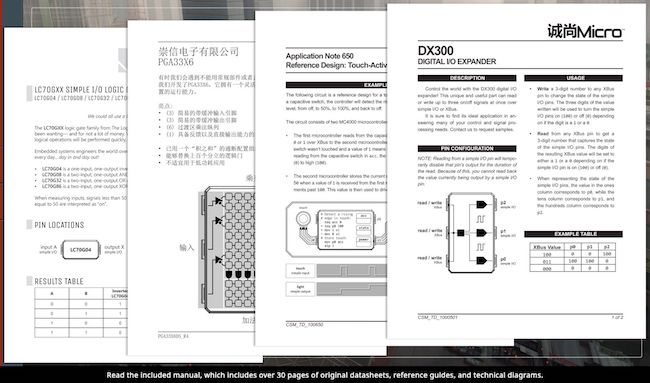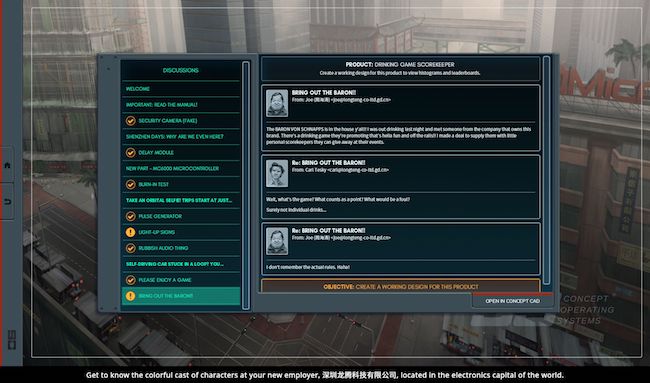
I have been a massive fan of Zachtronics’ games since they released SpaceChem back in 2011. Their unique puzzle games have always been able to suck me into hours upon hours of seemingly endless frustration and pondering. Their latest release, Shenzhen I/O, uses their usual assembly-style gameplay, this time with a programming twist and a printable manual. As such, it can be viewed as an elaboration of ideas explored in their previous release, TIS-100, but Shenzhen I/O absolutely stands on its own.
First and foremost, the most important thing to understand about this game, and all Zachtronics games, is difficulty. The road through Shenzhen I/O’s missions will require plenty of determination and persistence. Solutions to puzzles may often appear obvious at first glance, only to disappear as you attempt to actually create what you had envisioned. Upon realising this, you may even be required to completely abandon your ingenious idea and rethink this from scratch, even after hours of tweaking and adjustment.
The difficulty is further enhanced by how openly you can design your solutions. Restricted only by the borders of the level, you arrange your microprocessors, connect them with circuitry, and type in the code. There are no hints or suggestions on placement and arrangement, just the objective of the level as a distant goal. This inherently creates more complication in the form of the wide variety of solutions to every puzzle.

Luckily, Shenzhen I/O’s interface is quick and smooth. It’s simple to create copies of solutions to experiment with, and you’re able to leave notes within solutions to keep on top of what you intended. Easy drag-and-drop controls for the placement of the microprocessors makes general design snappy, and all the usual keyboard shortcuts you’d expect exist for typing in your code, with optional auto-formatting simplifying this further and helping keep the code very readable.
This code is ultimately going to be a large deciding factor in whether this game is something you’ll enjoy. It’s a language unique to the game, but relatively straightforward to learn and understand. I’ve always been interested in trying to learn code, so this faux-code was a delight to me. It’s fundamental to the game, so if you don’t share this interest, this may not be the game for you.
To assist with the process of learning the code, the game comes with a printable manual taken from the world of the game. It teaches you how to use the code, the functionality of the various microprocessors and some extra documents that are specifically relevant to certain puzzles. I have always been a fan of well written and useful manuals, so I adored this feature, especially as it replaces any semblance of a tutorial. The game expects you to have taken the time to read up in advance, in order to make headway into it.

The manual also does a fantastic job of setting the feel of the game. It was not uncommon for me to be at a loss on a puzzle, casually flicking through its pages in search of something to help my suffering mind. This did frequently bring a solution to light, greatly increasing the value and importance I placed on the manual the more I played. I would highly recommend following the game’s advice and printing this out for regular reference, as I guarantee you will be using it all game.
This constant need to refer to the manual comes from the fact that there are no simple catch-all solutions here. Each new puzzle demands more of your abilities and requires you to think of new ideas. You’ll need to constantly learn new ways of looking at the tools you’ve been given, so sticking firm to any preconceptions will be the doom of you. This ever-present difficulty encourages continued play, as the allure of finding out just what the game could throw at you next should capture the mind of any eager puzzle gamer.
Inversely, where the gameplay is an excellent motivator, there is no story to be found here. The context is well established through communication with your small team of co-workers, which slowly gives you a picture of the state of the world, but this is a poor substitute for an actual plot. This is clearly a deliberate design choice, and I know that not every game needs a narrative, but its absence may discourage players from persisting beyond the limits of their current abilities and really developing the skills required.

The lack of plot creates a second problem: puzzle burnout. Between the extreme difficulty of the puzzles and the fairly simple presentation, not having the interesting intermission of plot progression is very notable. There is some enjoyment to be had from the forum-like posts from your co-workers, but these very brief posts offer very little in the way of relief between puzzles. Due to this, I found myself having to walk away from the game several times to rest and regroup.
At the very least, there are some offerings of side fun that I enjoyed. A simple alteration of Solitaire becomes available early on that I played far more of than I should have. Designing your own puzzle is somewhat tricky, which makes it incredibly satisfying. There’s even a ‘puzzle’ in which you simply design your own game within the game. Unfortunately, I was never able to actually achieve this yet, but the premise is a good one. I will be back to conquer this challenge!
Returning to this Zachtronics title is their tried-and-tested leaderboard system, challenging you to improve on particular aspects of your puzzle design. These include concepts like ‘cost of design’ or ‘lines of code,’ and it’s a very neat way to compare your solutions against other players around the world. I have always found this design to be a fantastic incentive for returning to old puzzles with improved knowledge and making your designs as efficient as possible.
All of this is neatly wrapped together in a very clean presentation. From opening the game itself, it’s as if you’ve booted up your device to kick into work. It’s hardly anything I would call remarkable, but it’s impossible to fault it for this. The presentation of the puzzles themselves is fine until the puzzles get particularly more complex, at which point it can be hard to tell what’s what. Attempting to re-comprehend a messy page after being away for a day or two can be a challenge itself.

Zachtronics have a philosophy behind their designs that is easy to see. Shenzhen I/O is yet another embodiment of this, by encouraging experimentation and offering complex variation on simple ideas. While I would strongly encourage any lovers of the puzzle game genre to try this out, be prepared for a difficult time, particularly if this is your first venture into a Zachtronics game. You’ll need patience and an open mind, and if you make it through, you’ll come out the other end satisfied, smarter, and extremely exhausted.











